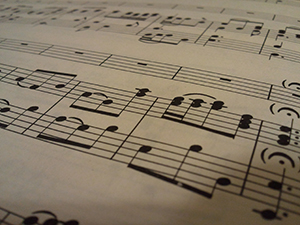Introduction to Music Notation

Music notation allows us to put sounds into writing. Although different systems are used around the world, the western system (which is used here) is the most prominent. Developing basic music reading skills is critical to the study of music, whether you are interested in performance, composition, music theory, musicology, or even sound engineering.
Music literacy allows you not only to read, but also to write music. Even if you are not interested in composing new music, having those skills will inform your performing and help you to adapt existing music to new performance scenarios (adapting a rock song for voice and ukulele, for example). Most importantly, reading music allows you to understand, study, and perform music that you have never heard before.
Elements of Music Notation
These terms and their corresponding symbols can be found in the notation glossary.
In music notation, sounds are represented by small circles (or ovals) called notes. Notes can be high or low, and they can be short or long. The higness or lowness of the note is its pitch. To represent high and low pitches, notes are placed high or low on the staff, the five horizontal lines going across the page.
To represent durations, the notes are written slightly differently on the page. For example, some notes are open ovals, while others are filled in. Graphic variations such as that are used to indicate longer and shorter notes.
Reading music is also similar to reading a book in any left-to-right language. You start in the upper left corner and go left-to-right and top-to-bottom across the page. As you move horizontally through the music, you are also moving forward in time. To put it another way, sequential events are aligned left-to-right and events aligned vertically happen simultaneously. Notes played in a sequence form a melody and notes played simultaneously form a harmony.
Other Types of Western Music Notation
Tablature (or tab) is a type of notation that shows both what to play and how to play it on a specific instrument. Guitar and ukulele tablature is common and widely available. Since tablature is specific to each instrument, it does not work well for a broad discussion of music and will not be covered here.
Another system is graphic notation, which is occasionally used for experimental and improvisational music. Graphic notation is not common and varies greatly from piece to piece, so will not be covered in this course.
Summary
- Notes are used to represent sounds
- Pitch (highness and lowness of the sounds) is represented vertically, i.e. high pitches are placed high on the staff (five horizontal lines)
- Duration is represented graphically, i.e. notes with different shapes have different durations
- Music is read left-to-right, top-to-bottom, just like a book
- The passage of time is represented horizontally, i.e. moving horizontally across the page means moving forward in time
- A melody is a sequence of notes
- A harmony is more than one note played simultaneously

